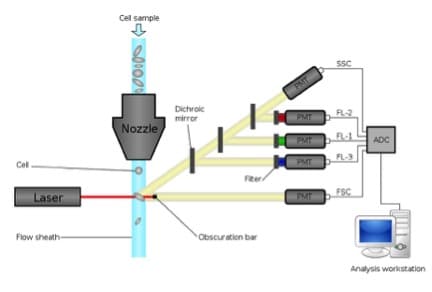While you can observe mitotic cell cycle progression using immunofluorescence, flow cytometry is a great tool to delineate details that aren’t apparent by chromosomal morphology alone. DNA stains are a great way to get a general idea of what your cells are up to. There are also a number of other stains you can use to put a finer point on the exact phases of the cell cycle represented in your population.
Here, I’ll paint a picture of the available stains you can use for cell cycle analysis.
The Big Picture: DNA Stains for Cell Cycle Analysis
Staining for DNA content is the simplest way to divide your cells into G0/G1, S, and G2/M phases. The principle behind this stain is that cells that have already doubled their DNA in G2/M have double the amount of fluorescence from DNA staining than those in G0/G1. In contrast, cells with intermediate amounts of DNA are in the process of DNA replication in S phase.
The most common dye for cell cycle analysis is Propidium Iodide (PI), however there are some downsides to this stain. PI binds to all double-stranded nucleotides and so you must use RNase in your samples to eliminate RNA signals. Additionally, for PI to enter into the cell and stain DNA, you must first fix and permeabilize your cells. Unfortunately, this is not always compatible with other fluorescent markers. If you have a UV laser, DAPI is DNA-specific and does not require RNase, but still requires permeabilization to get cell cycle information.
If you want to recover live cells from your flow cytometry sort, or avoid fixation, use other dyes. Some stains you may consider include Hoescht, 7AAD, DRAQ5 and DRAQ7, as well as Vybrant DyeCycle stains that come in an array of colors to allow for flexibility when designing your staining panels.
DNA staining has some limitations in cell cycle analysis. If you have aneuploidy in your cell populations, or if your cells are dying, you may have high or low signals that can skew your percentages. Additionally, DNA staining doesn’t differentiate between G0 and G1, or G2 and M phases. To do that, use additional markers.
Putting a Finer Point On It: Other Markers
Sometimes you may need to distinguish between cells in G0 vs G1, which look the same by DNA analysis alone. To separate these populations, combine DNA analysis with additional antibody stains to look for specific cell cycle markers. Here’s what to look for in these three cases:
- G0/G1: G0 cells are quiescent and lack cell cycle machinery. You may need to be separate them from G1 cells that have the ability to enter the cell cycle. You can take advantage of G0’s lack of cell cycle machinery: negative staining for cyclins D1 or E will reveal which cells have exited the cell cycle. These markers aren’t perfect however, as many early G1 cells may not express them yet. Alternatively, because cells in G0 are quiescent and less actively transcribing RNA, you can take advantage of their lack of RNA by staining with Pyronin Y. By comparing the staining of DNA and RNA, you can separate out cells in the G0/G1 peak with low RNA content as G0.
- G2/M: Cells in G2/M phase have twice the normal amount of DNA in their cells, but have very different functions. The most common marker for determining which cells are in mitosis is phosphorylated Histone 3 (pH3). It is active in mitotic cells between prophase and telophase. You can also use Cyclin A, which is expressed in late S/G2, but is absent during mitosis.
- Early/Late S Phase: Cyclin A is used to distinguish G2/M, but it is also expressed in late S phase. To separate early S phase, stain with Cyclin E. This protein is expressed in cells as they enter S phase but decreases as cells progress through DNA replication.
You’ll need antibody stains that all require permeabilization and fixation to look at these markers, so keep that in mind when selecting your DNA dye pairings.
Whether you use DNA alone or with other stains, flow cytometry is a powerful tool for cell cycle analysis.







